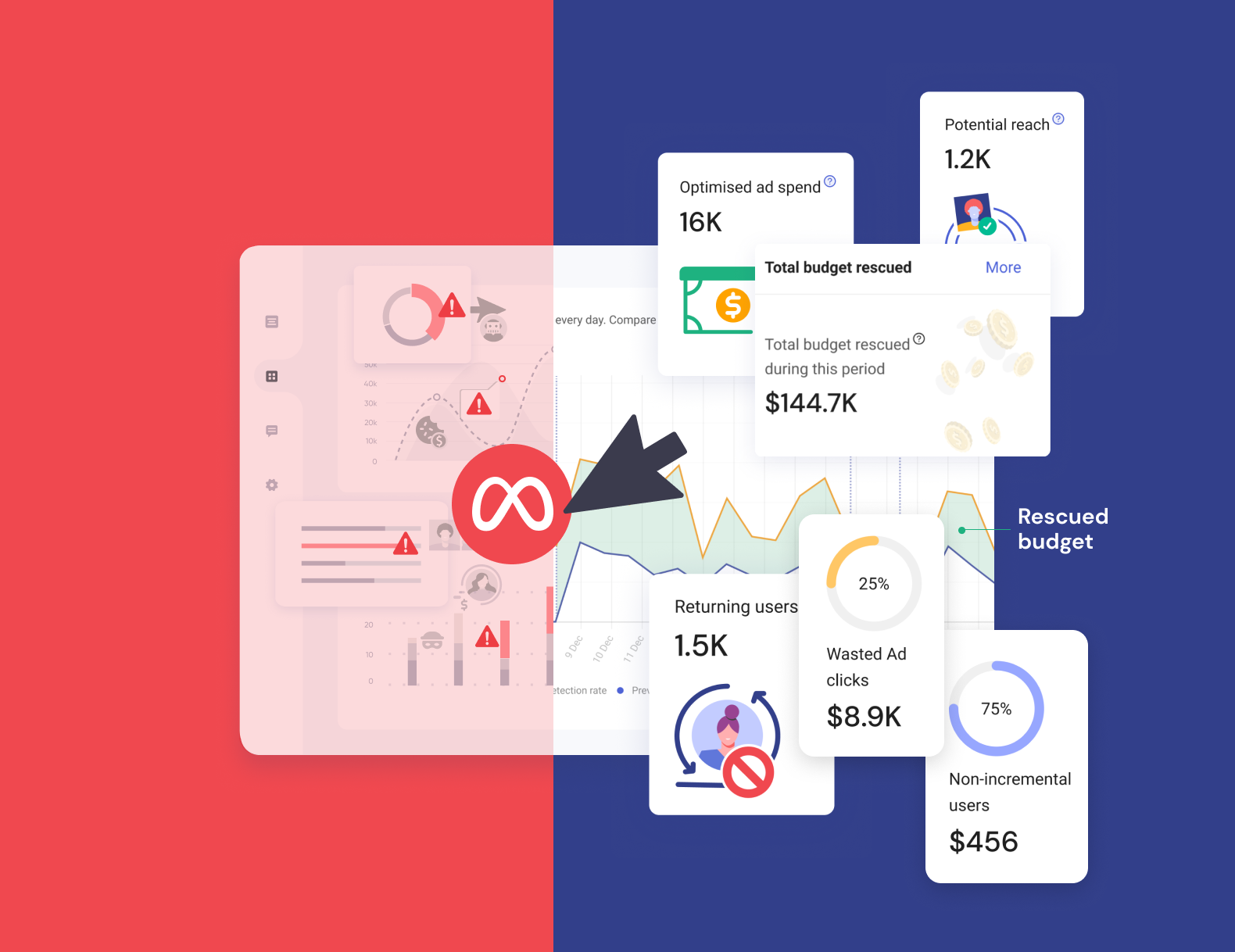Types of Click Fraud and How They Work

Click fraud remains a pervasive threat yet most digital marketers aren’t actively addressing it. Industry reports estimate that 81% of advertisers believe at least 10% of their ad traffic is fraudulent, and around 36% of digital ad spend globally is wasted on non-human or invalid clicks. This indicates that, while the issue is well-known, the vast majority of campaigns still lack robust fraud protection, leaving marketing budgets unnecessarily exposed.
Marketers continue to invest heavily in paid media, but many are leaving the door wide open to invalid traffic. Whether you’re running Google Ads, Mobile Network Install Campaigns or paid social, failing to actively protect your campaigns doesn’t just waste spend, it undermines performance and distorts decision-making.
In this guide, we break down the most common types of click fraud, how they operate, and why built-in platform protections are no longer enough for results-driven marketers.
12 Common Types of Click Fraud Explained
1. Competitor clicks
Competitors manually clicking your ads to drain your budget
Some competitors will go as far as repeatedly clicking your ads just to burn through your daily budget. Once your ads stop showing, they take over the top spots. Without detailed, campaign-level click data, these tactics often go unnoticed.
2. Click farms
Low-cost workers hired to click on ads repeatedly
Click farms use real humans to simulate genuine engagement, bypassing basic bot detection. These clicks appear valid in surface-level reports but rarely lead to meaningful action or conversion.
3. Botnet clicks
Distributed automated bots mimicking real users
Botnets consist of infected devices programmed to generate fraudulent clicks across a wide range of IP addresses and locations. These bots are sophisticated enough to mimic real browsing behaviour, making them difficult to detect without behavioural analysis.
4. Ad stacking
Multiple ads layered in one placement, invisible to users
Fraudsters stack multiple ads in a single ad slot. Only the top ad is visible to users, but all ads register impressions or clicks. You’re charged even when no one sees your creative.
5. Pixel stuffing
Shrinking ads to 1x1 pixels that still count as impressions
Ads are reduced to the size of a single pixel and embedded invisibly on a web page. They load technically, so you pay for impressions, but users never interact with them.
6. Click injection
Apps injecting clicks just before an install is registered
This mobile fraud tactic involves a malicious app generating clicks moments before an install occurs. It falsely claims credit for the install, distorting attribution and campaign ROI.
7. Domain spoofing
Fraudsters pretending to be premium publishers
Low-quality or non-existent websites disguise themselves as trusted publishers to attract higher ad rates. Advertisers think they’re buying inventory on a premium domain, but they’re not.
8. Geo masking
Masking traffic source location to appear legitimate
Fraudsters alter IP addresses or use proxies to disguise traffic from low-value regions as high-value users. This undermines geo-targeting and increases the cost of irrelevant traffic.
9. Incentivised clicks
Users paid or rewarded to click without intent
Clicks from users who are rewarded with points, tokens, or cash incentives have no genuine interest in your offering. These users click to gain rewards, not to convert.
10. Repetitive manual clicks
Abuse from humans clicking ads repeatedly with no purchase intent
Whether it’s a competitor, disgruntled user, or affiliate abusing a payout system, repetitive manual clicks can burn through budget quickly and skew engagement metrics.
11. App spoofing
Fake app traffic mimicking real installs or engagement
Fraudsters simulate installs or in-app events to mimic legitimate app activity. This type of fraud corrupts cost-per-install campaigns and undermines performance insights.
12. Unknown/advanced methods
New and evolving tactics that are harder to detect without proper tools
Fraudsters constantly adapt. Emerging threats like device emulators, AI-driven behaviour, or traffic laundering slip past standard filters. Staying ahead requires active monitoring and adaptive threat models.
Why Google Alone Isn’t Enough to Stop Click Fraud in Search Campaigns
Google Ads provides foundational click fraud detection designed to address the most apparent threats. However, its filters tend to operate retrospectively and offer limited transparency and control. As a result, advertisers may find it challenging to customise protection to fit the specific needs of their campaigns.
For marketers managing substantial budgets and aiming for peak campaign performance, relying exclusively on Google’s built-in protections may leave important gaps unaddressed. TrafficGuard complements these measures by providing detailed click-level insights, real-time blocking, and advanced optimisation tools, helping prevent click fraud before it impacts your spend or results.
How to Detect Click Fraud
Understanding and identifying click fraud begins with recognising unusual patterns in your campaign data. Sudden spikes in click-through rates (CTR) that aren’t matched by a rise in conversions often suggest invalid traffic. Careful monitoring of these trends over time is crucial to spotting anomalies early.
Equally telling are user engagement metrics. High bounce rates coupled with very short session durations may indicate automated visits or click farms rather than genuine user interest. When clicks fail to translate into meaningful interaction, it’s a strong signal that the traffic quality is compromised.
How to Block Click Fraud Manually
Once suspicious activity is identified, taking manual steps to block it is possible but can be labour-intensive and imprecise.
One common approach is to maintain and update IP blacklists to exclude sources that repeatedly generate questionable clicks. Additionally, setting frequency caps limits on how many times a single user or device can click within a certain timeframe can help reduce the impact of repeated or accidental clicks.
While these measures provide some control, their effectiveness is limited by the complexity and scale of modern digital campaigns, where fraudulent activity can be sophisticated and fast-moving.
Towards a More Industrialised Approach to Click Fraud Prevention
As digital marketing scales and fraud tactics grow more sophisticated, manual detection and blocking methods struggle to keep pace. What’s needed is an industrialised, data-driven approach that continuously analyses traffic at the click level and automates protection in real time.
TrafficGuard exemplifies this next generation of click fraud prevention technology. By leveraging advanced algorithms and machine learning, TrafficGuard identifies invalid clicks with precision, blocking them before they impact your campaigns. The platform offers granular visibility and customisable controls, empowering marketers to maintain campaign integrity while focusing on growth.
This blend of automation, real-time validation, and deep data insights represents the future of fraud prevention, transforming how marketers protect their spend and optimise performance in an increasingly complex digital landscape.
Final Thoughts
Click fraud has evolved. It’s no longer just bots and competitors; it’s a complex ecosystem of low-intent users, automation, and evolving scams. Left unchecked, it distorts campaign results and drains your marketing budget.
Prevention is not just about saving money. It’s about protecting the integrity of your data, the reach of your campaigns, and your ability to optimise towards business outcomes that matter. Already suspect something’s off with your campaign data? Here’s what to do when you detect invalid traffic.
FAQs and Key Takeaways
1. Why are we spending more but seeing fewer conversions?
If click volume is rising but conversions aren’t, it’s likely your ads are being triggered by invalid traffic such as bots, click farms, or repeat visitors. This drains budget and distorts performance data. To take control, marketers need deeper visibility into what’s driving each click. That’s where campaign-level analytics and traffic validation tools come into play. They give you the clarity to optimise spend and protect growth.
2. We’re already using Google’s filters, why isn’t that enough?
Google’s built-in filters work behind the scenes and mostly catch the obvious threats. But they don’t offer transparency into what’s being blocked or why, and they act after the click, not before. Marketers need a layer of protection that is designed for them, one that shows what’s really happening in their Google Ads campaigns, flags subtle threats, and responds in real time.
3. How do we prevent click fraud before it impacts campaign performance?
The key is early detection. By understanding behavioural patterns such as excessive click frequency, session anomalies, and geo discrepancies, you can uncover threats before they skew your data or drain spend. Prevention is not just about blocking fraud; it’s about having the intelligence to adapt quickly and make every ad dollar count. See how to quantify the potential impact with our ad fraud calculator.
Get started - it's free
You can set up a TrafficGuard account in minutes, so we’ll be protecting your campaigns before you can say ‘sky-high ROI’.
Subscribe
Subscribe now to get all the latest news and insights on digital advertising, machine learning and ad fraud.








